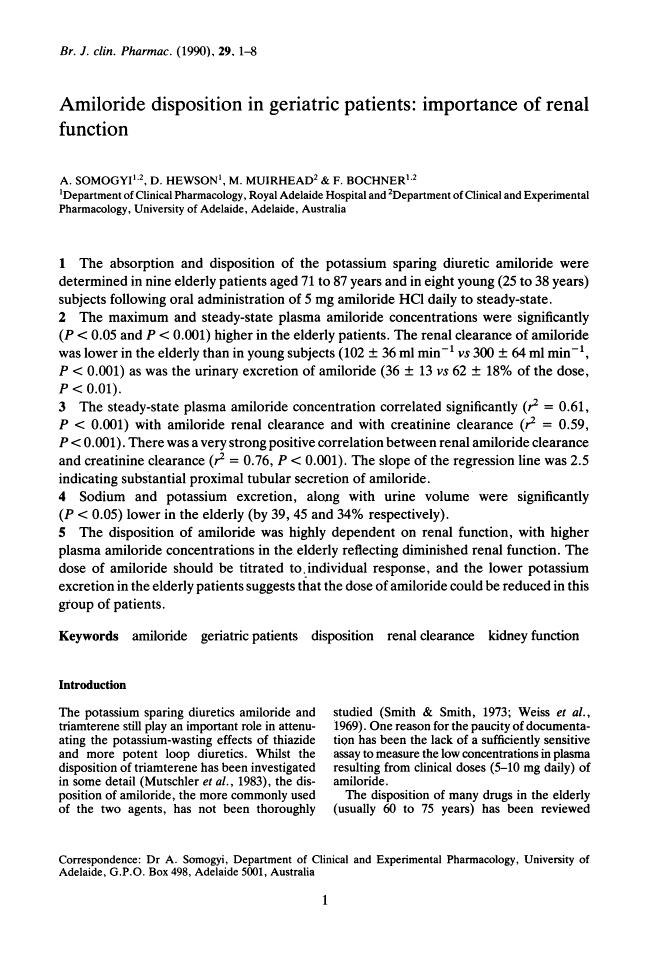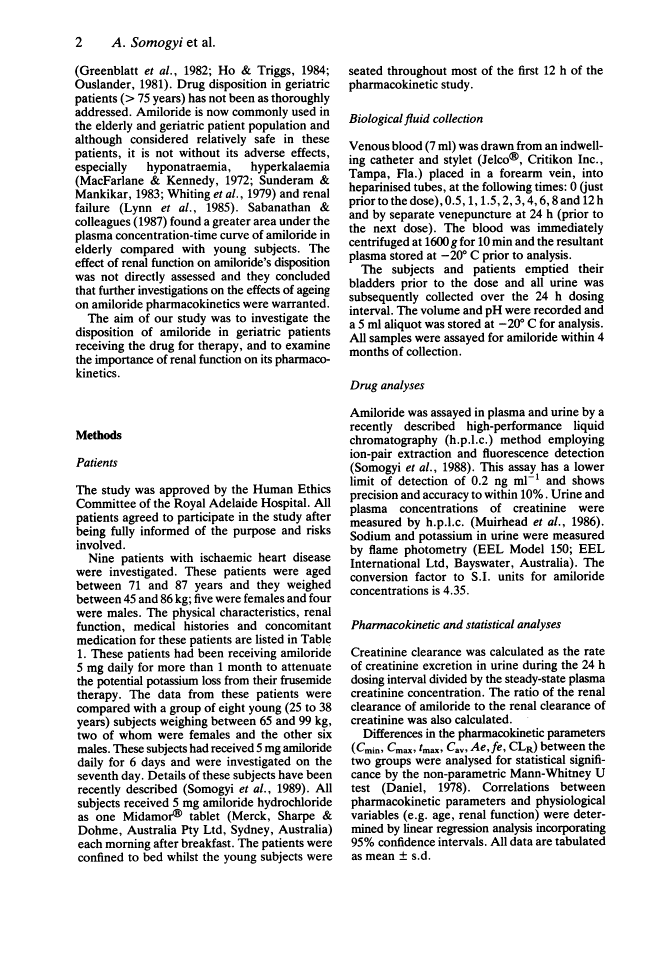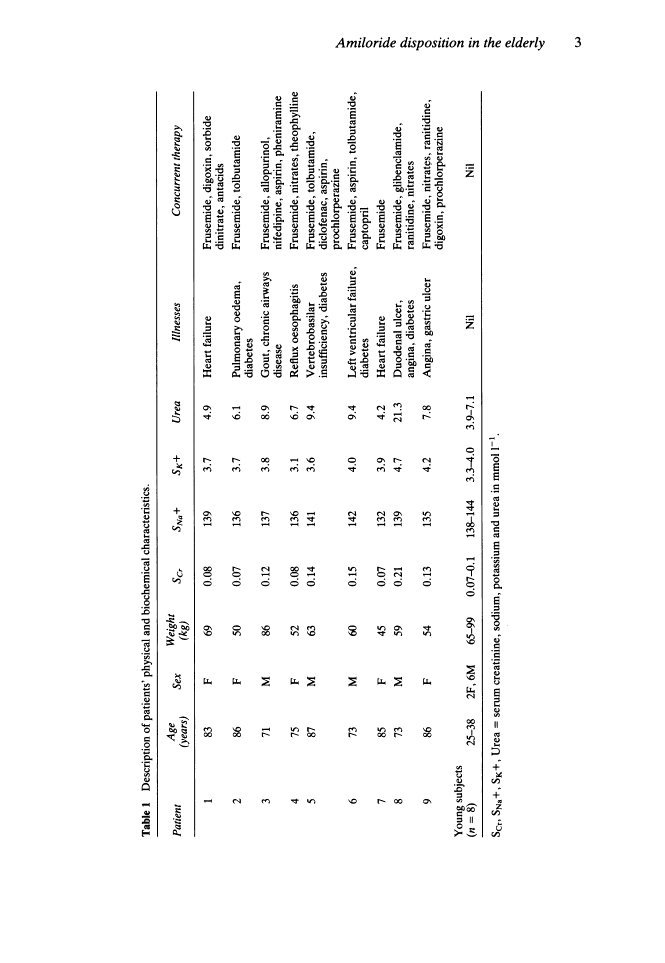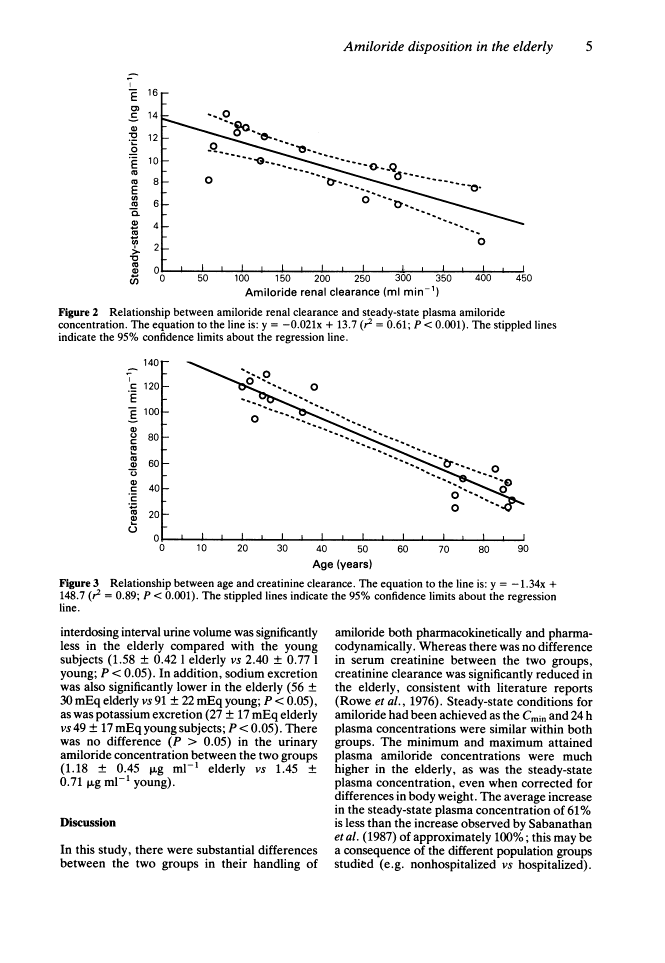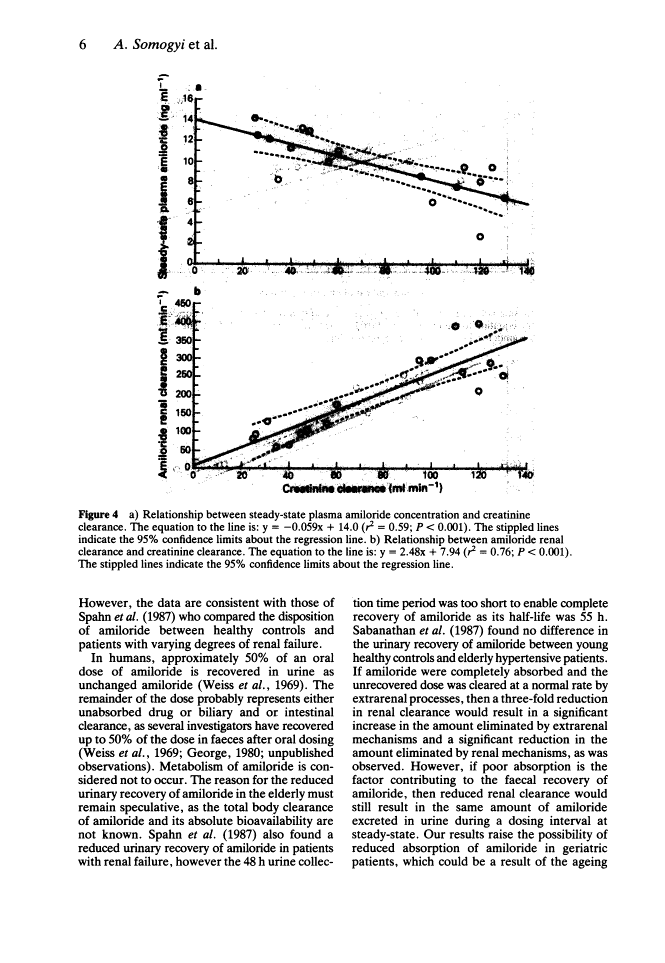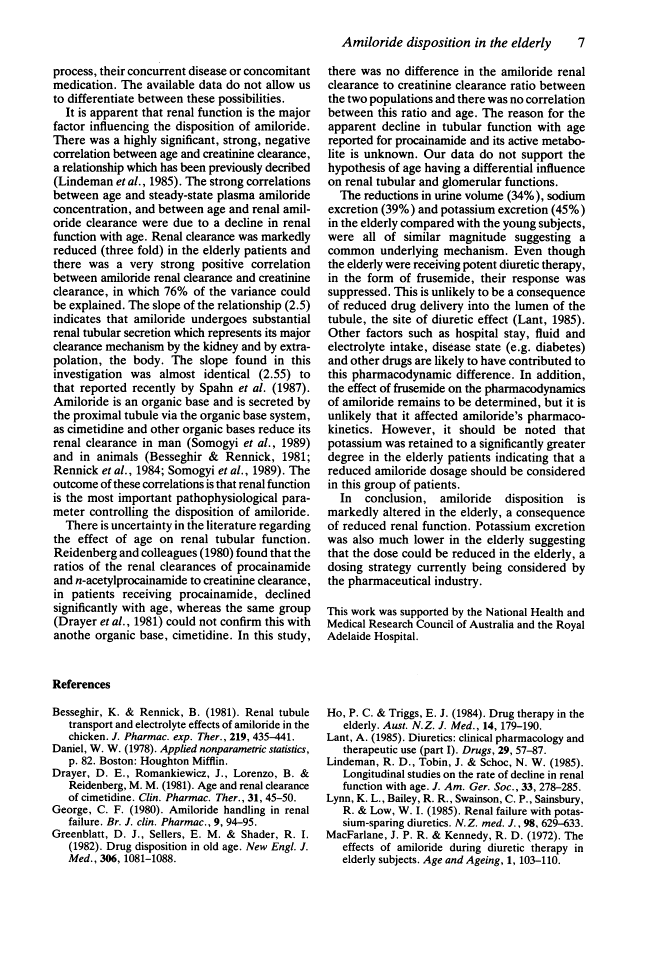Abstract
Free full text

Amiloride disposition in geriatric patients: importance of renal function.
Abstract
1. The absorption and disposition of the potassium sparing diuretic amiloride were determined in nine elderly patients aged 71 to 87 years and in eight young (25 to 38 years) subjects following oral administration of 5 mg amiloride HCl daily to steady-state. 2. The maximum and steady-state plasma amiloride concentrations were significantly (P less than 0.05 and P less than 0.001) higher in the elderly patients. The renal clearance of amiloride was lower in the elderly than in young subjects (102 +/- 36 ml min -1 vs 300 +/- 64 ml min-1, P less than 0.001) as was the urinary excretion of amiloride (36 +/- 13 vs 62 +/- 18% of the dose, P less than 0.01). 3. The steady-state plasma amiloride concentration correlated significantly (r2 = 0.61, P less than 0.001) with amiloride renal clearance and with creatinine clearance (r2 = 0.59, P less than 0.001). There was a very strong positive correlation between renal amiloride clearance and creatinine clearance (r2 = 0.76, P less than 0.001). The slope of the regression line was 2.5 indicating substantial proximal tubular secretion of amiloride. 4. Sodium and potassium excretion, along with urine volume were significantly (P less than 0.05) lower in the elderly (by 39, 45 and 34% respectively). 5. The disposition of amiloride was highly dependent on renal function, with higher plasma amiloride concentrations in the elderly reflecting diminished renal function. The dose of amiloride should be titrated to individual response, and the lower potassium excretion in the elderly patients suggests that the dose of amiloride could be reduced in this group of patients.
Full text
Full text is available as a scanned copy of the original print version. Get a printable copy (PDF file) of the complete article (939K), or click on a page image below to browse page by page. Links to PubMed are also available for Selected References.
Selected References
These references are in PubMed. This may not be the complete list of references from this article.
- Besseghir K, Rennick B. Renal tubule transport and electrolyte effects of amiloride in the chicken. J Pharmacol Exp Ther. 1981 Nov;219(2):435–441. [Abstract] [Google Scholar]
- Drayer DE, Romankiewicz J, Lorenzo B, Reidenberg MM. Age and renal clearance of cimetidine. Clin Pharmacol Ther. 1982 Jan;31(1):45–50. [Abstract] [Google Scholar]
- George CF. Amiloride handling in renal failure. Br J Clin Pharmacol. 1980 Jan;9(1):94–95. [Europe PMC free article] [Abstract] [Google Scholar]
- Greenblatt DJ, Sellers EM, Shader RI. Drug therapy: drug disposition in old age. N Engl J Med. 1982 May 6;306(18):1081–1088. [Abstract] [Google Scholar]
- Ho PC, Triggs EJ. Drug therapy in the elderly. Aust N Z J Med. 1984 Apr;14(2):179–190. [Abstract] [Google Scholar]
- Lant A. Diuretics. Clinical pharmacology and therapeutic use (Part I). Drugs. 1985 Jan;29(1):57–87. [Abstract] [Google Scholar]
- Lindeman RD, Tobin J, Shock NW. Longitudinal studies on the rate of decline in renal function with age. J Am Geriatr Soc. 1985 Apr;33(4):278–285. [Abstract] [Google Scholar]
- Lynn KL, Bailey RR, Swainson CP, Sainsbury R, Low WI. Renal failure with potassium-sparing diuretics. N Z Med J. 1985 Aug 14;98(784):629–633. [Abstract] [Google Scholar]
- MacFarlane JP, Kennedy RD. The effects of amiloride during diuretic therapy in elderly subjects. Age Ageing. 1972 May;1(2):103–110. [Abstract] [Google Scholar]
- Muirhead MR, Somogyi AA, Rolan PE, Bochner F. Effect of cimetidine on renal and hepatic drug elimination: studies with triamterene. Clin Pharmacol Ther. 1986 Oct;40(4):400–407. [Abstract] [Google Scholar]
- Mutschler E, Gilfrich HJ, Knauf H, Möhrke W, Völger KD. Pharmacokinetics of triamterene. Clin Exp Hypertens A. 1983;5(2):249–269. [Abstract] [Google Scholar]
- Ouslander JG. Drug therapy in the elderly. Ann Intern Med. 1981 Dec;95(6):711–722. [Abstract] [Google Scholar]
- Rennick B, Ziemniak J, Smith I, Taylor M, Acara M. Tubular transport and metabolism of cimetidine in chicken kidneys. J Pharmacol Exp Ther. 1984 Feb;228(2):387–392. [Abstract] [Google Scholar]
- Reidenberg MM, Camacho M, Kluger J, Drayer DE. Aging and renal clearance of procainamide and acetylprocainamide. Clin Pharmacol Ther. 1980 Dec;28(6):732–735. [Abstract] [Google Scholar]
- Rowe JW, Andres R, Tobin JD, Norris AH, Shock NW. The effect of age on creatinine clearance in men: a cross-sectional and longitudinal study. J Gerontol. 1976 Mar;31(2):155–163. [Abstract] [Google Scholar]
- Sabanathan K, Castleden CM, Adam HK, Ryan J, Fitzsimons TJ. A comparative study of the pharmacokinetics and pharmacodynamics of atenolol, hydrochlorothiazide and amiloride in normal young and elderly subjects and elderly hypertensive patients. Eur J Clin Pharmacol. 1987;32(1):53–60. [Abstract] [Google Scholar]
- Smith AJ, Smith RN. Kinetics and bioavailability of two formulations of amiloride in man. Br J Pharmacol. 1973 Aug;48(4):646–649. [Europe PMC free article] [Abstract] [Google Scholar]
- Somogyi AA, Hovens CM, Muirhead MR, Bochner F. Renal tubular secretion of amiloride and its inhibition by cimetidine in humans and in an animal model. Drug Metab Dispos. 1989 Mar-Apr;17(2):190–196. [Abstract] [Google Scholar]
- Somogyi A, Keal J, Bochner F. Sensitive high-performance liquid chromatographic assay for determination of amiloride in biologic fluids using an ion-pair extraction method. Ther Drug Monit. 1988;10(4):463–468. [Abstract] [Google Scholar]
- Spahn H, Reuter K, Mutschler E, Gerok W, Knauf H. Pharmacokinetics of amiloride in renal and hepatic disease. Eur J Clin Pharmacol. 1987;33(5):493–498. [Abstract] [Google Scholar]
- Sunderam SG, Mankikar GD. Hyponatraemia in the elderly. Age Ageing. 1983 Feb;12(1):77–80. [Abstract] [Google Scholar]
- Weiss P, Hersey RM, Dujovne CA, Bianchine JR. The meetabolism of amiloride hydroloride in man. Clin Pharmacol Ther. 1969 May-Jun;10(3):401–406. [Abstract] [Google Scholar]
- Whiting GF, McLaran CJ, Bochner F. Severe hyperkalaemia with Moduretic. Med J Aust. 1979 May 5;1(9):409–409. [Abstract] [Google Scholar]
Associated Data
Articles from British Journal of Clinical Pharmacology are provided here courtesy of British Pharmacological Society
Full text links
Read article at publisher's site: https://doi.org/10.1111/j.1365-2125.1990.tb03595.x
Read article for free, from open access legal sources, via Unpaywall:
https://bpspubs.onlinelibrary.wiley.com/doi/pdfdirect/10.1111/j.1365-2125.1990.tb03595.x
Citations & impact
Impact metrics
Citations of article over time
Article citations
Age-related modifications in CYP-dependent drug metabolism: role of stress.
Front Endocrinol (Lausanne), 14:1143835, 24 May 2023
Cited by: 9 articles | PMID: 37293497 | PMCID: PMC10244505
Review Free full text in Europe PMC
Is dry eye disease the same in young and old patients? A narrative review of the literature.
BMC Ophthalmol, 22(1):85, 22 Feb 2022
Cited by: 15 articles | PMID: 35193524 | PMCID: PMC8861619
Review Free full text in Europe PMC
Analysis of the variability of the pharmacokinetics of multiple drugs in young adult and elderly subjects and its implications for acceptable daily exposures and cleaning validation limits.
Int J Hyg Environ Health, 220(4):659-672, 20 Mar 2017
Cited by: 0 articles | PMID: 28396010
Review
Aging: a predisposition to dry eyes.
J Ophthalmol, 2014:781683, 14 Aug 2014
Cited by: 45 articles | PMID: 25197560 | PMCID: PMC4150485
Review Free full text in Europe PMC
Cardiovascular drug therapy in elderly patients: specific age-related pharmacokinetic, pharmacodynamic and therapeutic considerations.
Drugs Aging, 22(11):913-941, 01 Jan 2005
Cited by: 19 articles | PMID: 16323970
Review
Go to all (11) article citations
Similar Articles
To arrive at the top five similar articles we use a word-weighted algorithm to compare words from the Title and Abstract of each citation.
The pharmacokinetics of amiloride-hydrochlorothiazide combination in the young and elderly.
Eur J Clin Pharmacol, 37(2):167-171, 01 Jan 1989
Cited by: 6 articles | PMID: 2792171
Renal tubular secretion of amiloride and its inhibition by cimetidine in humans and in an animal model.
Drug Metab Dispos, 17(2):190-196, 01 Mar 1989
Cited by: 14 articles | PMID: 2565210
Aging effects on the organic base transporter and stereoselective renal clearance.
Clin Pharmacol Ther, 62(2):117-128, 01 Aug 1997
Cited by: 13 articles | PMID: 9284847
Pharmacokinetics of amiloride in renal and hepatic disease.
Eur J Clin Pharmacol, 33(5):493-498, 01 Jan 1987
Cited by: 17 articles | PMID: 3428342
